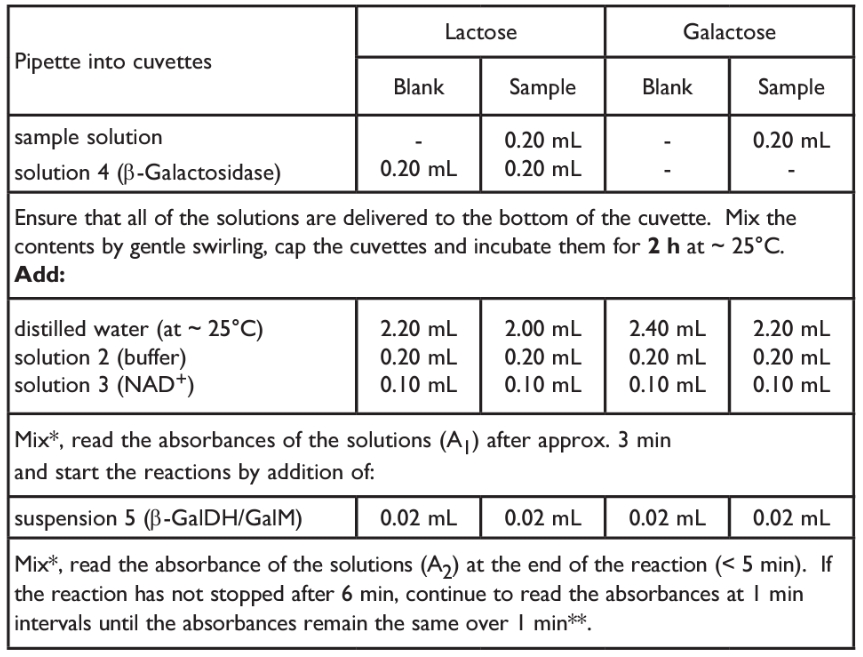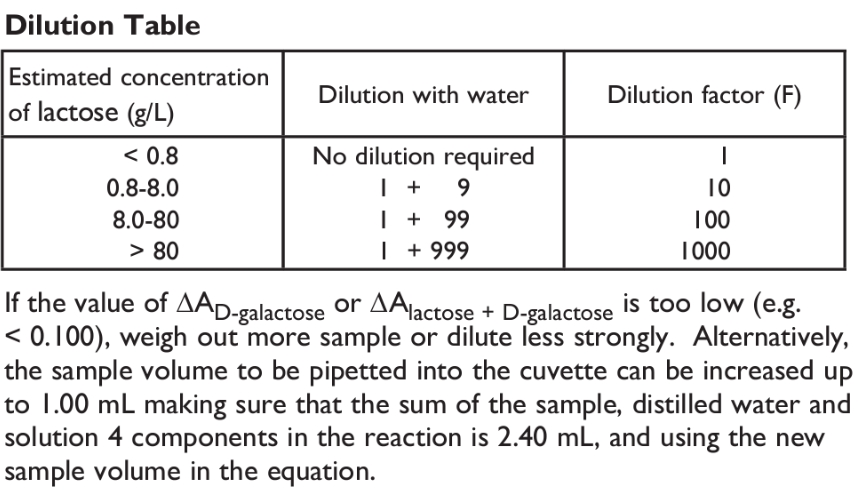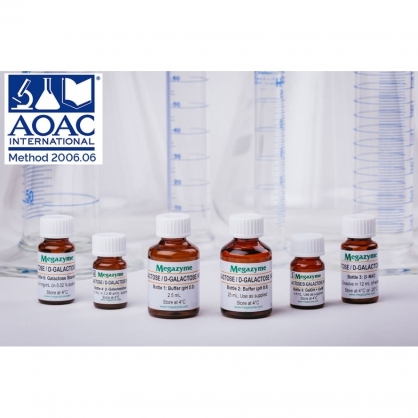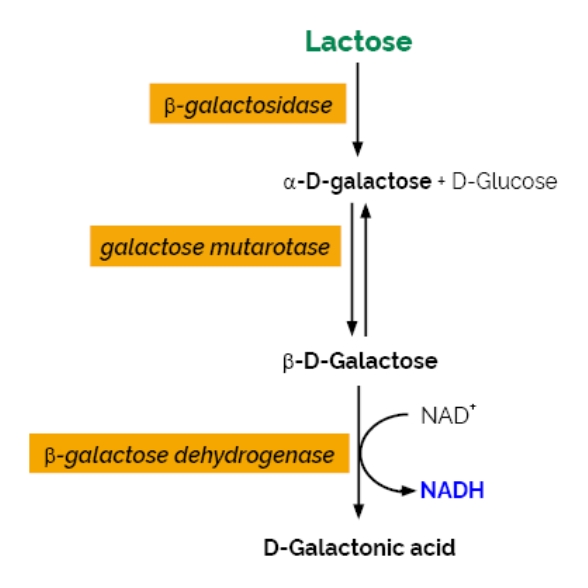- 背景資料
乳糖(Lactose)為一種雙醣,由一分子的半乳糖和一分子的葡萄糖以ꞵ(1,4)糖苷鍵鍵結而成,乳糖的食物來源主要以乳製品為主。近年來因為「乳糖不耐症」的因素,進而使市場推出了低乳糖(low-lactose)或無乳糖(lactose-free)的產品,以此滿足消費者的需求。在食品工業上為了去除乳製品中的乳糖,會利用β-半乳糖苷酶(β-galactosidase)將乳糖水解成一分子的半乳糖和一分子的葡萄糖,但此時β-半乳糖苷酶亦會表現出轉半乳糖活性(transgalactosylation)(轉移醣苷化作用)(轉醣反應)(醣轉反應)(酵素半乳糖複合物與各種醣類結合),進而生合成出一些寡糖類物質,此類寡糖物質被稱為半乳寡糖(galacto-oligosaccharides ,簡稱GOS)。
半乳寡糖(galacto-oligosaccharides ,簡稱GOS),為一種益生元(prebiotic),其結構上由數個半乳糖以β構型鍵結形成,聚合度(Degree of polymeration, DP)為二至八,因β-半乳糖苷酶來源、半乳寡糖的聚合度、鍵結方式、位置..等差異性,故會產生諸多種類之鍵結異構物(Linkage isomers)。此外,在食品工業上常利用高濃度乳糖為基質,並以β-半乳糖苷酶進行轉醣反應來大量生產半乳寡糖 。
在低乳糖或無乳糖的乳製品中,因加入β-半乳糖苷酶(轉醣反應),故產品中亦會產生多種半乳寡糖(例如:allolactose),其半乳寡糖含量可能與產品中乳糖含量相當或更多。因此,低乳糖或無乳糖的乳製品在乳糖含量之檢測上較為困難。
- PROCEDURE A: (Standard Assay Procedure)



- PROCEDURE B:
(For “low-lactose” or “lactose-free” samples containing high levels of monosaccharides)
Step 1:
Add 1 mL of milk (or homogenised sample) to 4 mL of water, mix then add 1 mL of 10 mg/mL sodium borohydride (dissolved in 50 mM NaOH and less than 5 h old). Incubate this solution in a sealed plastic container at 40°C for 30 min then neutralise by the addition of 2.5 mL of 0.2 M acetic acid. Filter through Whatman No. 1 filter paper or centrifuge in a microfuge at 13,000 x g and use the filtrate or supernatant directly in the assay or with an appropriate dilution in distilled water (if required). The filtrate will be hazy but this is stable in the assay and contributes very little to the absorbance. Typically use a sample volume of 0.2 mL. in Step 2.
Step 2:



- SAMPLE PREPARATION
1. Sample dilution.
The amount of D-galactose present in the cuvette (i.e. in the 0.2 mL of sample being analysed) should range between 4 and 80 μg (i.e. lactose in the sample solution used should range between approx. 8 and 160 μg). The sample solution must therefore be diluted sufficiently to yield a lactose concentration between 0.04 and 0.80 g/L.

2. Sample clarification.
a. Solutions:
Carrez I solution. Dissolve 3.60 g of potassium hexacyanoferrate (II) {K4[Fe(CN)6].3H2O} (Sigma cat. no. P9387) in 100 mL of distilled water. Store at room temperature.
Carrez II solution. Dissolve 7.20 g of zinc sulphate (ZnSO4.7H2O) (Sigma cat. no. Z4750) in 100 mL of distilled water. Store at room temperature.
Sodium hydroxide (NaOH, 100 mM). Dissolve 4 g of NaOH in 1 L of distilled water. Store at room temperature.
b. Procedure:
Pipette 1 mL of the liquid sample into a 100 mL volumetric flask which contains approx. 60 mL of distilled water, or weigh sufficient quantity of the sample into a 100 mL volumetric flask and add 60 mL of distilled water. Carefully add 5 mL of Carrez I solution, 5 mL of Carrez II solution and 10 mL of NaOH solution (100 mM). Mix after each addition. Fill the volumetric flask to the mark, mix and filter.
3. General considerations.
(a) Liquid samples: clear, slightly coloured and approximately neutral, liquid samples can be used directly in the assay.
(b) Acidic samples: if > 0.1 mL of an acidic sample is to be used undiluted (such as wine or fruit juice), the pH of the solution should be increased to approx. 8.6 using 2 M NaOH, and the solution incubated at room temperature for 30 min.
(c) Carbon dioxide: samples containing a significant amount of carbon dioxide, such as beer, should be degassed by increasing the pH to approx. 8.6 with 2 M NaOH and gentle stirring, or by stirring with a glass rod.
(d) Coloured samples: an additional sample blank, i.e. sample with no β-GalDH/GalM may be necessary in the case of coloured samples.
(e) Strongly coloured samples: if used undiluted, strongly coloured samples should be treated by the addition of 0.2 g of polyvinylpolypyrrolidone (PVPP)/10 mL of sample. Shake the tube vigorously for 5 min and then filter through Whatman No. 1 filter paper.
(f) Solid samples: homogenise or crush solid samples in distilled water and filter if necessary.
(g) Samples containing fat: extract such samples with hot water at a temperature above the melting point of the fat, e.g. in a 100 mL volumetric flask at 60°C. Adjust to room temperature and fill the volumetric flask to the mark with water. Store on ice or in a refrigerator for 15-30 min to allow separation of the fat and then filter. Discard the first few mL of filtrate and use the clear supernatant (which may be slightly opalescent) for assay. Alternatively, clarify with Carrez reagents.
(h) Samples containing protein: deproteinise samples containing protein by adding an equal volume of ice-cold 1 M perchloric acid with mixing. Centrifuge at 1,500 g for 10 min and neutralise the supernatant with 1 M KOH. Alternatively, clarify with Carrez reagents.
商品特色
商品規格
- 商品規格 115 檢測反應
Bottle 1:
Buffer (2.5 mL, pH 5.0).
Stable for > 2 years at 4°C.
Bottle 2:
Buffer (25 mL, pH 8.6) plus EDTA and sodium azide (0.02% w/v) as a preservative.
Stable for > 2 years at 4°C.
Bottle 3:
NAD+.
Stable for > 5 years below -10°C.
Bottle 4:
β-Galactosidase suspension (1.2 mL).
Stable for > 4 years at 4°C.
Bottle 5:
β-Galactose dehydrogenase plus galactose mutarotase suspension, 2.4 mL.
Stable for > 2 years at 4°C.
Bottle 6:
D-Galactose standard solution (5 mL, 0.4 mg/mL in 0.02% w/v sodium azide).
Stable for > 2 years; store sealed at 4°C.



